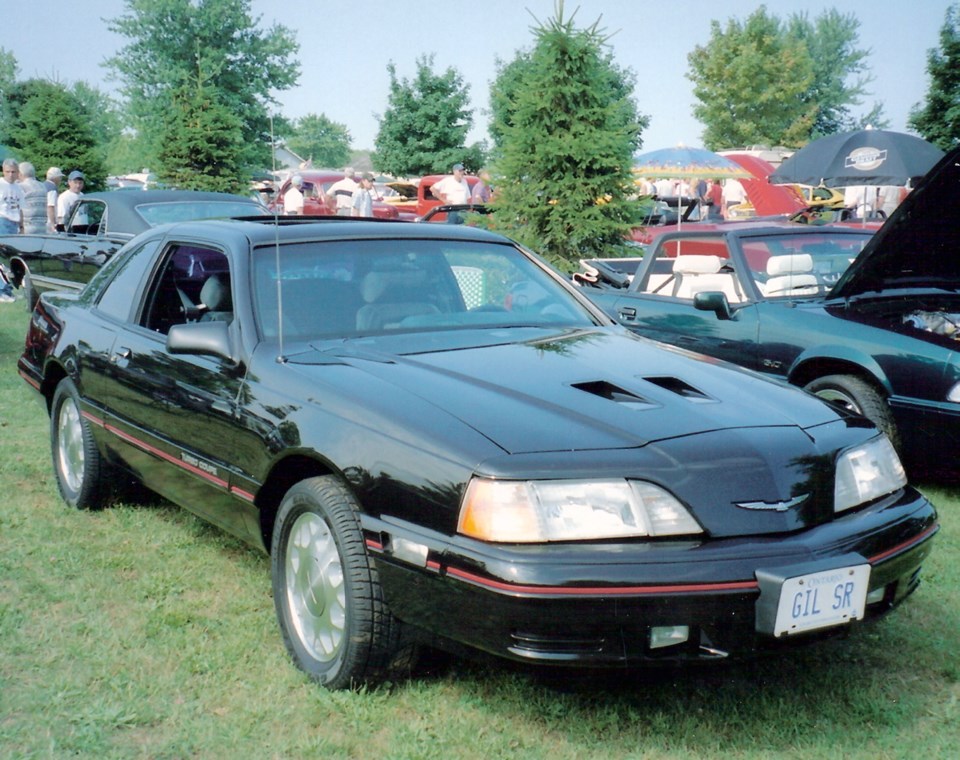Since its arrival as a 1955 model, the Ford Thunderbird was strongly associated with V-8 engines. In fact, for the first 27 years of its life, until 1981, it had them exclusively.
In 1982, fuel economy concerns brought a V-6 to accompany the eight. And much to the chagrin of V-8 fans, in 1983 the T-Bird came as a six only. Ford then began covering all the bases for the next five years with sixes and eights, and for the first time ever a four in the 1984 T-Bird.
Four cylinders in a Thunderbird was seen as an aberration for a car that had established its market niche as a good-performing personal luxury car with lots of velour, vinyl roofs and opera windows. Part of that image included the power and smoothness of a V-8. A four was definitely out of place under the hood.
Ford knew it had to offer a special more dashing image along with the T-Bird’s four cylinders, so it replaced its baroque, squared-up appearance with a completely restyled body.
Its sleek and quite daring aero shape was almost European, with its tightly drawn lines and steeply raked windshield. It was a harbinger of Ford’s aerodynamic mainstream future that would reveal itself with the 1986 Ford Taurus/Mercury Sable.
But the T-Bird’s aspiration to look European was just the beginning. Ford had something even more Continental up its sleeve: a high-revving four-cylinder powerplant it hoped would be attractive to enthusiasts who might be considering a European car.
When the T-Bird’s reincarnation was completed, Ford sent it out into the world to test the marketplace. The four-cylinder Thunderbird Turbo Coupe arrived as a mid-year model in 1983. Under its hood was a revised version of the 2.3-litre, single-overhead-cam, turbocharged engine that had been used in the Mustang, the car whose platform it shared.
It had been improved with port fuel injection and the latest electronic engine management system to control ignition timing and fuel flow. Long intake manifold runners gave better low-speed torque, and turbo boost was increased from the Mustang’s six pounds per square inch to 10 psi. Horsepower increased from 130 to 145.
In an attempt to control the solid rear axle’s wheel-hop tendencies under hard acceleration, engineers added two horizontal shock absorbers at the back, for a total of four. Modified MacPherson struts were used in front, and power went to the rear wheels through a five-speed manual transmission and limited-slip differential.
Performance was adequate, with the 2.3-litre four pushing the 1,424-kilogram coupe to 100 km/h in 9.1 seconds, and a top speed of 198 km/h (Car and Driver, July 1983).
There were no major changes for 1984, 1985 and 1986, although there were improvements such as a better instrument panel and bigger tires. The Turbo Coupe sold about 15,000 copies, about 10 per cent of total T-Bird annual sales.
To inject even more excitement, Ford gave the 1987 Turbo Coupe a restyling featuring a smooth, grille-less nose and flush-fitting headlamps and windows, all contributing to improved aerodynamics. It got four-wheel, anti-lock disc brakes and shock absorbers that automatically switched their compliance from regular to firm in spirited driving.
The four got a hormone injection with the turbo intercooler from the now-dead Mustang SVO. Dual exhausts and other tuning tricks resulted in a sizzling 190 horsepower when mated to the five-speed manual.
Those opting for the four-speed automatic had to be satisfied with only 150 horsepower from a non-intercooled engine. The 190 horsepower improved zero to 100 km/h to 8.0 seconds with the manual and top speed to 221 km/h.
The Thunderbird Turbo Coupe stayed around for one more year when Ford discontinued the four in favour of a supercharged V-6, which was not only faster but was almost as fuel-efficient. The V-8 also continued.
While the Thunderbird Turbo Coupe was a bold attempt by Ford to enter the exotic, high-tech world, it was not a great sales success, partly because buyers didn’t really relate to a four-cylinder Thunderbird.
Also, the four seemed rough and noisy compared with the V-8 and V-6 and many imported fours. And since most T-Bird buyers weren’t too concerned about fuel economy, this wasn’t a strong selling point.
The Thunderbird would be discontinued in 1997 due to slow sales, but the nameplate had too much goodwill to languish very long. It returned for 2002 with a retro 1950s motif, and — guess what? — two seats, just as it started with almost 50 years earlier. Under the hood was a V-8 engine, just as God and T-Bird enthusiasts intended. It stayed until 2005.



